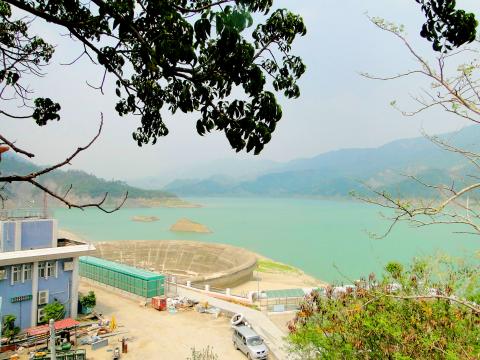Civic groups and residents from Pingtung County and Greater Kaohsiung yesterday held a protest in front of the Environmental Protection Administration just as officials were about to hold an environmental impact assessment meeting on construction of the “Gaoping Great Lakes” (高屏大湖) as part of a water diversion project in the south.
The protesters said the 697 hectare artificial lakes, planned by the Water Resources Agency’s Southern Region Water Resources Office, would greatly affect the water supply for shrimp farming, agriculture and household use.
The Gaoping Great Lakes project, located at the border of Pingtung County’s Ligang Township (里港) and Greater Kaohsiung’s Meinong District (美濃), was initially known as the Jiyang artificial lake project, an alternative plan to the Zengwun River (曾文溪) Cross-Border Channeling project that passed an assessment in 2002.

Photo: Tsai Wen-chu, Taipei Times
However, the Jiyang artificial lake project faced strong opposition from local residents and environmentalists throughout the decade, with construction budgets having been cut many times by the legislature over the years.
The now-renamed project was bundled with a project to ensure stable water supply in the area, with planned construction costing an estimated NT$16.1 billion (US$545.5 million).
Representatives from more than 35 civic groups opposing the project said it would turn farmland about 27 times the size of Da-an Forest Park in Taipei into artificial lakes 12m deep, and 3m-to-5m dikes would obstruct the groundwater and rainwater for irrigation in the area, causing even more serious flood problems.
“It doesn’t make sense to sacrifice the lives of us local residents and pump water from the area where we live to supply water to other areas,” said You Chi-ching (尤啟精), warden of Ligang’s Jhonghe Village (中和).
Taiwan Solidarity Union Legislator Lin Shih-chia (林世嘉) said the dikes risked blocking rainwater infiltration and causing floods in Greater Kaohsiung’s Meinong and Cishan districts (旗山), as well as Ligang Township, during the rainy season.
The tapwater leakage rate in Greater Kaoshiung was about 24 percent, the protesters said, urging the agency to spend money on improving the water-channeling leakage problem in the area instead of spending billions of dollars to build the artificial lakes.

US climber Alex Honnold is to attempt to scale Taipei 101 without a rope and harness in a live Netflix special on Jan. 24, the streaming platform announced on Wednesday. Accounting for the time difference, the two-hour broadcast of Honnold’s climb, called Skyscraper Live, is to air on Jan. 23 in the US, Netflix said in a statement. Honnold, 40, was the first person ever to free solo climb the 900m El Capitan rock formation in Yosemite National Park — a feat that was recorded and later made into the 2018 documentary film Free Solo. Netflix previewed Skyscraper Live in October, after videos

NUMBERS IMBALANCE: More than 4 million Taiwanese have visited China this year, while only about half a million Chinese have visited here Beijing has yet to respond to Taiwan’s requests for negotiation over matters related to the recovery of cross-strait tourism, the Tourism Administration said yesterday. Taiwan’s tourism authority issued the statement after Chinese-language daily the China Times reported yesterday that the government’s policy of banning group tours to China does not stop Taiwanese from visiting the country. As of October, more than 4.2 million had traveled to China this year, exceeding last year. Beijing estimated the number of Taiwanese tourists in China could reach 4.5 million this year. By contrast, only 500,000 Chinese tourists are expected in Taiwan, the report said. The report

Temperatures are forecast to drop steadily as a continental cold air mass moves across Taiwan, with some areas also likely to see heavy rainfall, the Central Weather Administration (CWA) said. From today through early tomorrow, a cold air mass would keep temperatures low across central and northern Taiwan, and the eastern half of Taiwan proper, with isolated brief showers forecast along Keelung’s north coast, Taipei and New Taipei City’s mountainous areas and eastern Taiwan, it said. Lows of 11°C to 15°C are forecast in central and northern Taiwan, Yilan County, and the outlying Kinmen and Lienchiang (Matsu) counties, and 14°C to 17°C

STEERING FAILURE: The first boat of its class is experiencing teething issues as it readies for acceptance by the navy, according to a recent story about rudder failure The Hai Kun (海鯤), the nation’s first locally built submarine, allegedly suffered a total failure of stern hydraulic systems during the second round of sea acceptance trials on June 26, and sailors were forced to manually operate the X-rudder to turn the submarine and return to port, news Web site Mirror Daily reported yesterday. The report said that tugboats following the Hai Kun assisted the submarine in avoiding collisions with other ships due to the X-rudder malfunctioning. At the time of the report, the submarine had completed its trials and was scheduled to begin diving and surfacing tests in shallow areas. The X-rudder,